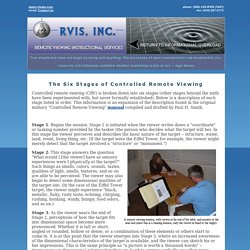

Athene's Theory of Everything. The CRV Manual: Stage I. A.

Concept: Any given site has an overall nature or "gestalt," as it is referred to below, that makes it uniquely what it is. In Stage I, the remote viewer is taught to acquire the signal line, attune himself to it, and proceed to decode and objectify this site getalt and the major pieces of information that pertain to it. A properly executed Stage I is the very foundation of everything that follows after it, and it is therefore of utmost importance to maintain correct structure and achieve an accurate Stage I concept of the site.
All CRV sessions begin with Stage I. B. 1. 2. 3. 4. C. For training in Stage I, a stage-specific site is selected. D. There are four types of ideograms: IDEOGRAMS - THE FOUNDATION OF Controlled remote Viewing (CRV). - Remote Viewed - News. Background before you start Ideograms:An early article from me on Ideograms – Also please read the two CRV manuals and my Open source CRV documents description and use of ideograms:1985 – Tom McNear CRV Training notes/manual – 1990’s Paul H Smith Military CRV manual (Microsoft Word) – (Adobe .pdf) – Daz Smith – Open source CRV (guide) – OK, so Ideograms are the foundation of Controlled remote viewing.

They are the initial impacting ball of data form the target to you that you then expand and spend the next hour unraveling as a remote viewing session. When you write your target number and go straight into the Ideogram process you physical arm reflects the nature of e target instantaneously by generating a subconscious ‘doodle’.
For the first Stage of CRV (Controlled remote Viewing) what we need to do is start the process of creating an Indeogram language inside of you and a clarified from of communication from one level of consciousness to another. How do we create this language? Six stages of CRV. Controlled remote viewing (CRV) is broken down into six stages (other stages beyond the sixth have been experimented with, but never formally established).

Below is a description of each stage listed in order. This information is an expansion of the description found in the original military "Controlled Remote Viewing" manual compiled and drafted by Paul H. Smith. Stage 1: Begins the session. ESP Every Day - Transcendencies Transcendencies. It happens to you.

For some reason, out-of-the-blue, thoughts about a person you know pop into your head. The phone rings. Surprise! The person about whom you were thinking is calling you. Or, you’re in the kitchen humming a song. Events like these happen to all of us at one time or another. We don’t understand a great deal about the way our brain works and yet, we think, we plan, we wonder. The Seventh Sense ESP is an ability to receive or send information above and beyond what may be attributable only through our five objective senses of sight, sound, smell, taste, or touch. (Amazon), makes a case that the sixth sense is not psychic, but is a “sense of ambience.” Buchanan notes that ambience is often experienced or felt, “sensed”, in a similar manner among people in certain places or situations.
The Silva Mind Control Method Similar to Buchanan, Jose Silva, founder of the famed Silva Method of Mind Development and Stress Control had his own spin on ESP.
SIMPLIFIED. Applications. IRVA - What is Remote Viewing. Remote viewing is a mental faculty that allows a perceiver (a "viewer") to describe or give details about a target that is inaccessible to normal senses due to distance, time, or shielding.

For example, a viewer might be asked to describe a location on the other side of the world, which he or she has never visited; or a viewer might describe an event that happened long ago; or describe an object sealed in a container or locked in a room; or perhaps even describe a person or an activity; all without being told anything about the target -- not even its name or designation. From this explanation, it is obvious that remote viewing is related to so-called psi (also known as "psychic" or "parapsychological") phenomena such as clairvoyance or telepathy.
Whatever it is that seems to make it possible for human beings to do remote viewing is probably the same underlying ability that makes such things as clairvoyance work. Copyright © Paul H. Astropod's Technical Remote Viewing Web Site.
Paul Smith. Moorehouse. Stephen Schwartz. McMonEagle.